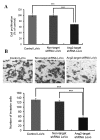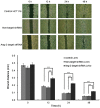Oncogenic function of angiopoietin-2 in vitro and its modulation of tumor progression in colorectal carcinoma
- PMID: 28693205
- PMCID: PMC5494651
- DOI: 10.3892/ol.2017.6203
Oncogenic function of angiopoietin-2 in vitro and its modulation of tumor progression in colorectal carcinoma
Abstract
Angiopoietin-2 (Ang-2) has been investigated in cancer primarily in terms of its angiogenic function, and its role as an oncogene has yet to be elucidated. The current study hypothesized that Ang-2 may be an oncogene and have a function in tumor progression. An investigation of the function of Ang-2 in the LoVo colorectal cancer (CRC) cell line in vitro, which expresses a high level of Ang-2, was performed by knocking down endogenous expression with a targeted short hairpin RNA. The aggressive phenotypic effects of Ang-2 on experimental and control group cells were assessed using cell proliferation, migration and invasion assays. The association between Ang-2 expression levels and clinicopathological factors was evaluated in 415 CRC tissues using immunohistochemistry. Suppressing Ang-2 expression decreased cellular proliferation, invasion and migration in an in vitro study. Ang-2 overexpression was observed in 46% of patients with CRC and was significantly associated with pT (P=0.048), pN (P<0.001), venous invasion (P=0.023), lymphatic invasion (P<0.001) and tumor-node-metastasis stage (P=0.022). Furthermore, Ang-2 overexpression was an independent prognostic factor in pN stages 1 and 2. These results reveal that Ang-2 may be an oncogene in colorectal carcinogenesis and its expression may exert aggressive phenotypic effects during tumor progression. In addition, Ang-2 expression may serve as a prognostic marker and a potential drug target.
Keywords: Angiopoietin-2; Colorectal carcinoma; Oncogenic function; shRNA.
Figures




Similar articles
-
Expression and prognostic significance of angiopoietin in colorectal carcinoma.J Surg Oncol. 2006 Dec 1;94(7):631-8. doi: 10.1002/jso.20423. J Surg Oncol. 2006. PMID: 17066421
-
[Abnormal expression of angiopoietin-2 associated with invasion, metastasis and prognosis of lung cancer].Zhonghua Yi Xue Za Zhi. 2018 Apr 24;98(16):1261-1266. doi: 10.3760/cma.j.issn.0376-2491.2018.16.015. Zhonghua Yi Xue Za Zhi. 2018. PMID: 29747316 Chinese.
-
MicroRNA-21 (Mir-21) Promotes Cell Growth and Invasion by Repressing Tumor Suppressor PTEN in Colorectal Cancer.Cell Physiol Biochem. 2017;43(3):945-958. doi: 10.1159/000481648. Epub 2017 Sep 29. Cell Physiol Biochem. 2017. PMID: 28957811
-
Clinical significance of angiopoietin-2 expression at the deepest invasive tumor site of advanced colorectal carcinoma.Int J Oncol. 2004 Mar;24(3):539-47. Int J Oncol. 2004. PMID: 14767538
-
Clinicopathological and prognostic implications of polo-like kinase 1 expression in colorectal cancer: A systematic review and meta-analysis.Gene. 2019 Dec 30;721:144097. doi: 10.1016/j.gene.2019.144097. Epub 2019 Sep 4. Gene. 2019. PMID: 31493507
Cited by
-
Targeted Nano-Drug Delivery of Colchicine against Colon Cancer Cells by Means of Mesoporous Silica Nanoparticles.Cancers (Basel). 2020 Jan 7;12(1):144. doi: 10.3390/cancers12010144. Cancers (Basel). 2020. PMID: 31936103 Free PMC article.
-
Anti-angiogenesis in colorectal cancer therapy.Cancer Sci. 2024 Mar;115(3):734-751. doi: 10.1111/cas.16063. Epub 2024 Jan 17. Cancer Sci. 2024. PMID: 38233340 Free PMC article. Review.
-
Expression of Spermine Oxidase Is Associated with Colorectal Carcinogenesis and Prognosis of Patients.Biomedicines. 2022 Mar 8;10(3):626. doi: 10.3390/biomedicines10030626. Biomedicines. 2022. PMID: 35327428 Free PMC article.
-
A Phase II Study of FOLFIRI Plus Ziv-Aflibercept After Trifluridine/Tipiracil Plus Bevacizumab in Patients with Metastatic Colorectal Cancer: WJOG 11018G.Target Oncol. 2024 Mar;19(2):181-190. doi: 10.1007/s11523-024-01043-2. Epub 2024 Mar 1. Target Oncol. 2024. PMID: 38427280 Free PMC article. Clinical Trial.
References
-
- Fiedler U, Krissl T, Koidl S, Weiss C, Koblizek T, Deutsch U, Martiny-Baron G, Marmé D, Augustin HG. Angiopoietin-1 and angiopoietin-2 share the same binding domains in the Tie-2 receptor involving the first Ig-like loop and the epidermal growth factor-like repeats. J Biol Chem. 2003;278:1721–1727. doi: 10.1074/jbc.M208550200. - DOI - PubMed
-
- Tanaka F, Ishikawa S, Yanagihara K, Miyahara R, Kawano T, Li M, Otake Y, Wada H. Expression of angiopoietins and its clinical significance in non-small cell lung cancer. Cancer Res. 2002;62:7124–7129. - PubMed
LinkOut - more resources
Full Text Sources
Other Literature Sources
Research Materials
Miscellaneous
